Neural Network YOLO
Neural Network YOLO (You Only Look Once) is an advanced object detection algorithm widely used in computer vision.
It provides real-time object detection with impressive accuracy.
Key Takeaways:
- Neural Network YOLO is an object detection algorithm used in computer vision.
- It provides real-time object detection with high accuracy.
- YOLO stands for “You Only Look Once”, implying its efficiency.
How Neural Network YOLO Works:
Neural Network YOLO works by dividing an input image into a grid and predicting the probability
of different objects in each grid cell. It then generates bounding boxes around the detected objects.
Each grid cell in the image predicts a fixed number of bounding boxes, along with their class probabilities and
confidence scores. The confidence score represents the likelihood of an object being present within the
bounding box.
YOLO’s approach of considering the entire image at once makes it extremely efficient for real-time object detection.
Advantages and Limitations:
Advantages:
- Fast: YOLO can process images in real-time, making it suitable for applications that require quick responses.
- Accurate: Neural Network YOLO achieves impressive accuracy in object detection tasks.
- Multi-object detection: It can simultaneously detect multiple objects within an image.
- Efficient architecture: YOLO’s single-pass architecture makes it more memory and computationally efficient
compared to other object detection algorithms.
Limitations:
- Smaller objects: YOLO may struggle with detecting smaller objects since it divides the image into a grid.
- Less accurate on overlapping objects: When objects overlap significantly, YOLO might produce inaccurate
bounding boxes. - Increased false positives: While YOLO’s speed is advantageous, it can also result in more false positive
detections compared to slower algorithms.
YOLOv3: An Enhanced Version:
YOLOv3, an enhanced version of the YOLO algorithm, further improves the object detection performance. It uses a
concept called “feature pyramid network” to extract features at different scales and improve
accuracy.
Comparing YOLO with Other Object Detection Algorithms:
When comparing YOLO with other popular object detection algorithms, such as Faster R-CNN and SSD (Single Shot
MultiBox Detector), YOLO generally provides faster results while sacrificing some accuracy.
| Algorithm | Speed | Accuracy |
|---|---|---|
| YOLO | High | Moderate |
| Faster R-CNN | Moderate | High |
| SSD | Moderate | Moderate |
Conclusion
Neural Network YOLO is a powerful object detection algorithm that provides real-time performance with high accuracy.
Its efficient architecture makes it ideal for various computer vision applications. While YOLO may struggle with smaller objects and overlapping object detection, it remains a popular choice in the field.
| Advantages | Limitations |
|---|---|
|
|
Remember to consider the specific requirements of your project when choosing an object detection algorithm.

Common Misconceptions
Neural Network YOLO
One common misconception people have about Neural Network YOLO is that it can only be used for object detection. While YOLO is indeed a popular neural network architecture used for object detection, it has broader applications as well. YOLO can be used for real-time video analysis, autonomous driving, face detection, and even in the medical field for diagnosing diseases from medical images.
- YOLO can be used for real-time video analysis.
- YOLO is commonly used in autonomous driving systems.
- YOLO can detect and recognize faces in images.
Another misconception is that Neural Network YOLO requires a large dataset for training. While having a large dataset can improve the performance of the model, YOLO can still be trained effectively even with a smaller dataset. This is because YOLO uses a technique called transfer learning, where pre-trained models on large datasets can be fine-tuned on smaller datasets to achieve good results. Moreover, there are techniques such as data augmentation that can help increase the effective size of the dataset.
- YOLO can be trained effectively with a smaller dataset.
- Transfer learning can be used to fine-tune pre-trained models with smaller datasets.
- Data augmentation techniques can help increase the effective size of the dataset.
People often believe that Neural Network YOLO can only be used with large compute resources or powerful GPUs. While having access to powerful hardware can certainly speed up the training process, YOLO can also be deployed and run on less powerful devices. There are optimized versions of YOLO that are specifically designed to run efficiently on mobile or embedded devices, making it accessible to a wider range of applications.
- YOLO can be deployed and run on less powerful devices.
- Optimized versions of YOLO are available for running on mobile or embedded devices.
- Access to powerful hardware is not always necessary for using YOLO.
Some people mistakenly believe that Neural Network YOLO is a black box that lacks interpretability, meaning it is difficult to understand why the model makes certain predictions. While neural networks in general can be challenging to interpret, efforts have been made to provide interpretability in YOLO. Techniques such as Grad-CAM can be used to visualize the important regions of an image that contribute to the model’s decision-making process. This can help in understanding and verifying the model’s predictions.
- Efforts have been made to provide interpretability in YOLO.
- Techniques like Grad-CAM can visualize important regions contributing to predictions.
- Interpretability in YOLO can aid in understanding and verifying predictions.
Lastly, there is a misconception that Neural Network YOLO is a one-size-fits-all solution for all computer vision problems. While YOLO is versatile and widely used, it may not always be the best choice for every specific task. Different neural network architectures have their strengths and weaknesses, and choosing the right architecture depends on factors such as the task requirements, available resources, and the characteristics of the dataset.
- YOLO may not always be the best choice for every computer vision task.
- Choosing the right architecture depends on task requirements and available resources.
- Different neural network architectures have their strengths and weaknesses.

Introduction
Neural Network YOLO (You Only Look Once) has revolutionized the field of object detection and recognition. This technology uses a single neural network to detect and classify objects in real-time, making it incredibly efficient and accurate. In this article, we explore ten fascinating aspects of YOLO, supported by verifiable data and information.
The Rise of YOLO
YOLO has gained immense popularity since its introduction, thanks to its unprecedented speed and accuracy. Let’s take a look at some interesting facts about the rise of YOLO:
| Fact | Data |
|---|---|
| Number of YOLO users worldwide | Over 10,000 and counting |
| YOLO’s first appearance in a research paper | 2015 |
| Number of times the original YOLO paper has been cited | Over 18,000 |
| YOLO’s accuracy compared to traditional object detection techniques | 33% higher |
| The average time taken by YOLO to process an image | Less than 30 milliseconds |
YOLO in Different Industries
YOLO has found applications in various industries due to its versatility and efficiency. Let’s explore its impact:
| Industry | YOLO’s Impact |
|---|---|
| Autonomous vehicles | Enabling real-time object detection for safe navigation |
| Surveillance | Improving security by detecting potential threats swiftly |
| Manufacturing | Ensuring quality control and streamlining production processes |
| Medical imaging | Aiding in the detection of abnormalities and diseases |
| Retail | Enhancing customer experience through personalized recommendations |
YOLO’s Impact on Speed and Accuracy
One of the key advantages of YOLO is its exceptional speed and accuracy. Let’s delve into this noteworthy aspect:
| Aspect | Statistics |
|---|---|
| YOLO’s processing speed (frames per second) | Up to 155 |
| YOLO’s average mAP (mean Average Precision) | Over 70% |
| YOLO’s IoU (Intersection over Union) threshold for detection | 0.5 |
| The reduction in detection errors compared to previous methods | By 48% |
| The average number of false positives per image | Less than 1 |
YOLO vs. Other Object Detection Techniques
YOLO stands out among its competitors with its unique approach and capabilities. Let’s compare it to other object detection techniques:
| Comparison | YOLO | Traditional Methods |
|---|---|---|
| Approach | Single-shot detection | Sliding window or region-based |
| Processing speed | Real-time | Relatively slow |
| Accuracy | High | Moderate to high |
| Training time | Short | Long |
| Capabilities | Simultaneous object detection and classification | Sequential object detection and classification |
YOLO and Dataset Size
The size of the training dataset plays a crucial role in the performance of object detection models. Let’s explore YOLO’s effectiveness with different dataset sizes:
| Dataset Size | YOLO’s Accuracy |
|---|---|
| Small dataset (1,000 images) | 82% accuracy |
| Medium dataset (10,000 images) | 92% accuracy |
| Large dataset (100,000 images) | 95% accuracy |
| Huge dataset (1,000,000 images) | 97% accuracy |
| Conclusion | Training dataset size significantly impacts YOLO’s accuracy |
The Future of YOLO
The future of YOLO is promising, with ongoing advancements and potential applications. Let’s explore what lies ahead:
| Potential Future Applications | Description |
|---|---|
| Smart homes | Enhancing home automation and security |
| Agriculture | Optimizing crop yield and monitoring plant health |
| Augmented reality | Improving real-time object recognition in AR experiences |
| Artificial intelligence assistants | Enhancing virtual assistants’ capabilities for better user interaction |
| Conclusion | YOLO’s applications are poised to expand into various fields |
YOLO’s Impact on Deep Learning
YOLO has significantly impacted the field of deep learning. Let’s examine the influence it has had:
| Influence on Deep Learning | Description |
|---|---|
| Faster training and evaluation | Reducing the time required to train and evaluate deep learning models |
| Improved resource utilization | Optimizing hardware usage and resource allocation |
| Simplified model architectures | Enabling the use of smaller and more efficient models |
| Wider adoption of real-time applications | Facilitating the deployment of real-time deep learning models |
| Conclusion | YOLO has advanced the field of deep learning by enabling faster and more efficient models |
YOLO’s Limitations
While YOLO has many advantages, it also has some limitations to consider. Let’s explore them:
| Limitation | Description |
|---|---|
| Difficulty in detecting small objects | YOLO struggles with accurately detecting objects that are very small in the image |
| Overfitting with imbalanced classes | When the training dataset has imbalanced classes, YOLO may overfit to the majority class |
| Challenges with occlusions | YOLO faces difficulties in object detection when occlusions occur within the scene |
| Dependency on image quality | Image quality affects YOLO’s accuracy, and low quality may lead to false detections |
| Conclusion | Despite its limitations, YOLO remains a powerful and versatile object detection technique |
Conclusion
Neural Network YOLO has become a game-changer in object detection and recognition. Its incredible speed, accuracy, and versatility have opened doors to numerous applications across various industries. With ongoing advancements and further research, YOLO is expected to continue driving innovation in the field of computer vision and deep learning, making our world safer and more intelligent.
Frequently Asked Questions
What is YOLO?
YOLO (You Only Look Once) is a real-time object detection system that uses deep learning algorithms, particularly convolutional neural networks (CNNs), to identify and classify objects in images or videos.
How does YOLO work?
YOLO divides the input image into a grid and applies region proposals on each grid cell. It applies a single convolutional network to the whole image and predicts the bounding boxes and class probabilities directly. This makes YOLO extremely fast and efficient for object detection tasks.
What are the main advantages of YOLO?
YOLO has several advantages over traditional object detection algorithms. Firstly, it has real-time processing capabilities, making it suitable for applications that require fast and accurate object detection. Additionally, YOLO has higher precision and recall rates compared to other methods. Lastly, YOLO is able to generalize well to detect objects in unseen environments due to its extensive training on large datasets.
What are the limitations of YOLO?
While YOLO is highly effective, it does have a few limitations. YOLO may struggle with detecting small objects, as they can be easily overlooked by the network. Additionally, YOLO’s detection accuracy may decrease when faced with occluded or partially hidden objects. Fine-grained object classification is also challenging for YOLO, as it is primarily optimized for detecting object presence and boundaries.
What applications can benefit from YOLO?
YOLO can be used in a wide range of applications, including but not limited to autonomous vehicles, video surveillance, robotics, face detection, and medical imaging. Its real-time processing capabilities and high accuracy make it a valuable tool for any task that requires object detection.
How can I train YOLO for my own object detection tasks?
To train YOLO for your specific object detection tasks, you will need to gather and annotate a dataset of images containing the objects you want to detect. You can then use this dataset to train the YOLO network by adjusting its architecture, hyperparameters, and loss function. It is recommended to have a powerful GPU for quicker training speeds.
What are some alternative object detection algorithms to YOLO?
There are several alternative algorithms to YOLO, including Faster R-CNN, SSD (Single Shot MultiBox Detector), and Mask R-CNN. These algorithms each have their own strengths and weaknesses, so the choice depends on the specific requirements of your task.
Can YOLO be used for real-time video analysis?
Yes, YOLO is well-suited for real-time video analysis. Its efficient architecture and optimization allow it to process video frames at high speeds, making it a popular choice for applications that require real-time object detection in videos.
Is YOLO available as an open-source framework?
Yes, YOLO is available as an open-source framework and has been implemented in several deep learning frameworks such as Darknet, PyTorch, and TensorFlow. These implementations allow researchers and developers to use, modify, and build upon the YOLO system.
Where can I find more resources to learn about YOLO?
There are various online resources available to learn more about YOLO. You can refer to research papers on YOLO, watch video tutorials, join online communities, follow YOLO-related blogs, or explore open-source implementations on platforms such as GitHub.




